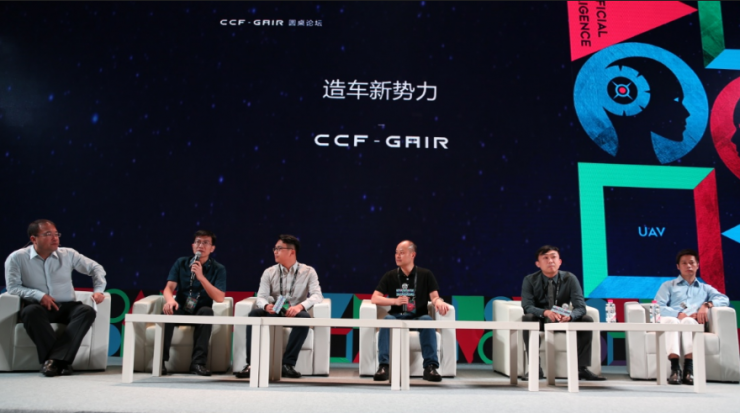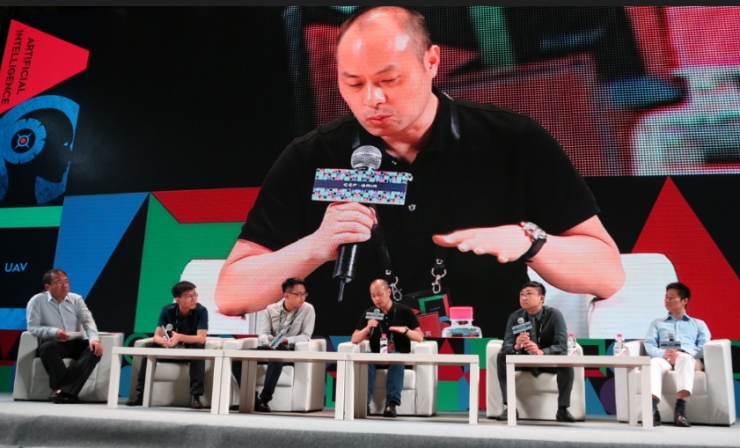Smart driving is no doubt in the general direction, but if there is no hardware, software, etc., it is all talk. The back-end supply market has also become a hot favorite. At the CCF-GAIR conference on smart driving, these back-end suppliers will tell us what they have done for the future of smart driving. (From left to right) Pisa Chunlin, Secretary-General of Telematics Industry Application Alliance (TIAA), Qiu Chunxin, CEO of Sagitar Creativity, Liu Guoqing, CEO of Minieye, Tang Jinsong, General Manager of Quanergy China, Yin Shangzhi, Chief Data Scientist of Huayuan Data, and QNX Corporation Greater China General Manager Zhang Renjie. Pang Chunlin: Introduce your company. Qiu Chunxin: Hello everybody, Sagitar Polytronics is a company that specializes in laser radar. In 2014, we released the first laser radar, which is mainly used in static surveying. Now our products focus on unmanned lidars. This one. Liu Guoqing: Minieye was established in April 2013. We focus on the perception of automotive technology. We hope to contribute to the automation and unmanned perception of automobiles. Tang Jinsong: We are doing laser radar. We have a lot of cooperation with many manufacturers. Many of our existing mechanical and rotary ones are working together. We also attach great importance to China, so our Asian headquarters is in Shanghai. Yin Xiangzhi: We are currently hosting an artificial intelligence contest. During the competition, we will provide 50,000 driving recorders to experience and carry out competitions related to smart driving algorithms. Zhang Renjie: Our operating system is widely used in various familiar models, including BMW, Volkswagen, etc. We have a lot of contributions in the new generation of automatic driving. Pang Chunlin: What do you think about Tesla's accidents in China and the United States? Qiu Chunxin: This reflects some of the deficiencies of unmanned driving, perhaps because laser radar has not yet been used, so the lack of awareness of the white body caused misjudgments. Liu Guoqing: Tesla has a problem with the definition of functional requirements for autonomous driving. You need to clearly define the scene of automatic driving, and continue to experiment to verify such features. Another point is to have a cloud mechanism, through the integration of multiple sensors - not only radar, but also lidar, one problem, the other can be connected. Tang Jinsong: From the technical point of view, it is because its system is not reliable enough to see the light and the side. In the future, we need to ensure the safety and reliability of the technology. We will set up some mechanisms on the fourth and fifth-level systems to ensure the safety of automatic driving. Yin Xiangzhi: This accident highlights the biggest obstacle to artificial intelligence at this stage: Machines can only recognize what we teach and cannot understand and judge extra events. So algorithms need to move from recognition to understanding and cognition so that accidents can be avoided. Zhang Renjie: Now our system security is divided into two types: functional security and systemic security. In terms of functional safety, Tesla's on-board systems are not available at present; while there are no backups for system security, the system is very weak on these two levels. Pang Chunlin: Will smart vehicles require a black box in the future? What are the devices that determine the trace and source of this signal command? Qiu Chunxin: Now judge the accident is carried out by driving recorder. In the unmanned era, the laser radar is not only installed in the car, but also in the vicinity of the road. The traffic conditions of the entire vehicle range can be very clear. In this way, monitoring is easier. Liu Guoqing: I think this is a must. There are two aspects that need to be considered: one is how car data is tamper-proof and the other is whether or not the information should be uploaded. Tang Jinsong: I think this is not a technical issue, but an insurance legal issue. In the past, we had concerns about privacy when it came to making big data. We also need to use car big data in future autopilot. After an accident, these privacy will be made public... This is a problem that we all need to face when new technologies enter life. In addition, I am more concerned about algorithms, how to train their ability through continuous simulation tests, this is very important. Zhang Renjie: I think that the black box is a way to make things up and it cannot change the fragile nature of the system. From the perspective of security, autopilot systems are divided into security domains and insecure domains. How to isolate the two domains is a very important issue, and it is necessary to resolve security risks at the source. There is the problem of power consumption, black box itself will have power consumption, and when the record, when not recorded, or SD failure, full of questions. Now more popular software-defined cars, the role of software in this system is growing, we can use the original multiple independent hardware functions through software. Pang Chunlin: In the current automatic driving car, do you think the sensor should be connected to an interface or multiple interfaces? Qiu Chunxin: External sensor data is input to the car. The amount is very large. In the process, I feel that the front-end camera or laser radar has certain data processing capabilities, providing the car itself with information necessary for making decisions. At this time, it is more appropriate to do terminal input or output together. Liu Guoqing: I think they can share one channel, but not necessarily all information is packaged together. In the stitching of information, I think it is necessary to think because data is really important for unmanned driving. Whether it is development or testing, when we have a clear definition of requirements, we need to carry out a lot of tests. Measurements must be needed. Information feedback helps us form a closed loop to iterate and gradually improve the function. Tang Jinsong: This is related to the future computing platform. What can be done is to be effective, safe, and reduce the burden of computing. It is hard to say what the middle structure is. It may take a lot of participation to find the best platform, including the GPU vendors. Yin Xiangzhi: There are many professional sensors and complex algorithms in the entire device. It is very difficult to solve it through a platform. Because there are different algorithms for various occasions, if it is really done, it is not very encouraging for innovative models. I think that after processing the data, it will be passed to the central system through a standard API. However, to define the surrounding areas requires the relevant manufacturers to participate in the development of standards. As for the accuracy of transmission, it depends on the performance of various vendors. Zhang Renjie: I personally support the trend of integration because the future car is a very powerful computing platform. I/O line cards are available for various sensors, cameras, laser radars, etc. I/O line card, the entire system will become very simple. In addition to using such an architecture can easily enhance its computing power, for example, the processor can not, can be upgraded; if there is no redundant backup, I can back up the GPU part ... can use similar functions The I/O line card solves the problem part, and it is constantly improving. Pang Chunlin: With regard to sensors, how do you look at the future development trend of automotive sensors and systems? The second is what good advice for real issues can promote this? Qiu Chunxin: At present, the initial heart of autopilot is to reduce the accident rate. This is unchanged. One of the reasons that Sagitar builds its own laser radar is that it is too expensive, so we do it ourselves so that I can answer your questions well now. The main question now is how to adapt to the requirements of the depot, and how to make it more stable. Like the camera or based on system integration is good, the current radar is a big one, everyone is very concerned, I believe the price will soon come down. Liu Guoqing: The main deciding factor in the price of sensors is its output. The cost reduction is only a matter of time. In terms of promotion, I recommend using a camera. There are several advantages: one is that the cost is lower and more friendly; the other is that in addition to having a large market for new cars, it is not bad in the stock market, but it can also improve. Existing traffic safety conditions. Tang Jinsong: Lidars need to look at 30 to 200 meters during automatic driving. The data volume is more than 200 points. It is the key to reduce the cost of materials at this time. The traditional lidar is rotating and is a combination. Each factory is to be adjusted. Laser products have not been mass-produced yet, so prices will not come; if you do different wavelengths, the cost will go up again, so the technical route will determine the cost, and the fixed cost will be allocated based on the amount. Yin Xiangzhi: I think business is an effective way. Commercial buyouts and even subsidies can be more effective. Zhang Renjie: Do we really need 16-line laser radar? The single-line camera +4 line laser radar must be very cheap, better than a single-line camera, why do we not do some low-end attempts? We always think very well in theory. In fact, we go too fast. We may choose lower-end configurations when the current price of laser radar is relatively high. For China, the current mainstream economic models are basically selling at a price of around 200,000 yuan. No one chooses a higher price, but for a commercial vehicle, adding a $8,000 laser radar to a 1.5 million vehicle is no problem. Therefore, it can be promoted in commercial vehicles. When the market reaches a certain amount, the price naturally comes down. Finally, the civilian models can also be popularized. Din Connector,Waterproof Cable Connector,Ip66 Wire Waterproof Connector,Waterproof Power Connector Shenzhen Hongyian Electronics Co., Ltd. , https://www.hongyiancon.com
